Distinguishing the Impacts of Rapid Urbanization on Ecosystem Service Trade-Offs and Synergies: A Case Study of Shenzhen, China
Abstract
:1. Introduction
2. Materials and Methods
2.1. Study Area
2.2. Data Sources
2.3. Remote Sensing Data Processing
2.4. Assessment of ESs
- (1)
- Supporting service is mainly calculated as habitat quality (HQ). Using the habitat quality module of the InVEST model, the evaluation result of the model is a dimensionless habitat quality index which ranges from 0 to 1. A higher value indicates better ecological quality and greater capacity to provide supporting services, and vice versa. This module comprehensively evaluates habitat quality based on the quality of the habitat itself (habitat suitability) and the comprehensive threat level to the threat sources (habitat degradation degree), as shown in Equation (1) [39].where Qxj is the habitat quality of grid x in landscape type j, Hj is the habitat suitability of landscape type j, Dxj is the degradation degree of grid x in landscape type j, and K is the half-saturation coefficient. Taking half of the highest degradation degree, z is the model parameter. The formula for calculating the degree of degradation is as follows:where Wr is the weight of threat source r, ry is the intensity of threat source r, irxy is the influence of threat source r in grid x, βx is the access degree of grid x, Sjr is the sensitivity of landscape type j to threat source r, Dxy is the distance between landscape grid x and threat grid y, and drmax is the maximum influence range of threat source r. By referring to similar previous studies [39,40,41,42,43,44], model parameters such as the weight of the threat source, the influence range and habitat suitability, and its sensitivity to the threat factors are set.
- (2)
- Regulating services are calculated for three ESs: carbon sequestration (CS), water yield (WY), and soil retention (SR). CS and WY are obtained using the carbon module and water yield module of the InVEST model, respectively. In the carbon module, the total carbon storage service is calculated as the sum of the carbon storage of aboveground vegetation, belowground vegetation, dead organic matter, and soil, as shown in Equation (5) [39], and the unit is t/pixel.where CS is the total carbon storage, Cabove, Cbelow, Cdead, and Csoil are the carbon storage of aboveground and belowground vegetation, dead organic matter, and soil, respectively. The module is based on land use data and carbon density data, which are mainly based on the results of previous studies on vegetation and soil carbon density [45,46,47,48], of which dead organic matter carbon storage is small and difficult to measure, and is ignored in this study.
- (3)
- Provisioning services are calculated for two kinds of production supply: grain production (GP) and fruit production (FP). The grain and fruit production data provided by the Shenzhen Statistical Yearbook, as well as the area of cropland and orchard land in the corresponding years, are used to spatially quantify the grain and fruit supply services at the grid scale in Shenzhen. The following formulas were used to allocate the GP and FP into pixel values:where Li is the grain production in pixel i, Si is the fruit production in pixel i, Ci and Oi are the area of the cropland and orchard in the pixel i, and PL and PS are the grain yield and fruit yield, respectively.
- (4)
- Park and recreation services (PR) are considered for cultural services. Parks are important recreational places for urban residents and can provide a variety of cultural services. Shenzhen has a complete park classification system and a large number of parks. The cultural service is represented by the park recreation service, and its value is determined by the coverage times of service scope and the service capacity of the park [53,54,55]. Four indicators, park area, type, naturalness, and water coverage, are selected to comprehensively evaluate park and recreation services. The weights of each indicator are obtained by the entropy weight method and are 0.32, 0.08, 0.09 and 0.51, respectively. Therefore, the calculation formula of park service capacity is as follows:
2.5. Analysis of ES Trade-Off and Synergy Relationships
2.6. Relationship between ESB and Urbanization
3. Results
3.1. Spatial and Temporal Variation of ESs
3.2. Evolution of ES Trade-Offs and Synergies
3.3. The Impact of Urbanization Intensity on ES Trade-Off and Synergy
4. Discussion
4.1. Urbanization Influence on ESs Relationship
4.2. Uncertainty and Limitation
5. Conclusions
Author Contributions
Funding
Data Availability Statement
Conflicts of Interest
Appendix A. Spatial Patterns of Changes in Ecosystem Services

Appendix B. Fitting of Ecosystem Service Pairs with Significant Trade-Offs and Synergies
| Ecosystem Services Pairs | Equation; R-Squared Value | ||||
|---|---|---|---|---|---|
| 1978 | 1990 | 2000 | 2010 | 2018 | |
| GP-HQ | y = 1.137x2 − 3.549x + 2.429; R2 = 0.729 | y = −0.633x2 + 0.431x + 0.139; R2 = 0.340 | y = −0.120x2 + 0.070x + 0.037; R2 = 0.101 | y = −0.087x2 + 0.071x + 0.010; R2 = 0.032 | y = −0.103x2 + 0.085x + 0.009; R2 = 0.020 |
| FP-HQ | y = −0.121x2 − 0.205x + 0.339; R2 = 0.187 | y = −1.167x2 + 0.997x + 0.090; R2 = 0.353 | y = −0.811x2 + 0.713x + 0.063; R2 = 0.266 | y = −0.610x2 + 0.583x − 0.013; R2 = 0.117 | y = −0.269x2 + 0.250x − 0.004; R2 = 0.353 |
| GP-CS | y = −0.258x2 − 0.779x + 0.923; R2 = 0.712 | y = −0.811x2 + 0.695x + 0.073; R2 = 0.345 | y = −0.224x2 + 0.199x + 0.012; R2 = 0.142 | y = −0.072x2 + 0.058x + 0.010; R2 = 0.030 | y = −0.090x2 + 0.077x + 0.007; R2 = 0.021 |
| FP-CS | y = −0.610x2 + 0.569x + 0.026; R2 = 0.193 | y = −1.535x2 + 1.506x − 0.024; R2 = 0.460 | y = −1.058x2 + 1.078x − 0.032; R2 = 0.386 | y = −0.396x2 + 0.367x + 0.003; R2 = 0.054 | y = −0.200x2 + 0.202x − 0.010; R2 = 0.028 |
| GP-SR | y = 4.288x2 − 3.121x + 0.519; R2 = 0.242 | y = 1.858x2 − 1.277x + 0.181; R2 = 0.147 | y = 0.501x2 − 0.332x + 0.044; R2 = 0.066 | y = 0.233x2 − 0.149x + 0.019; R2 = 0.018 | y = 0.308x2 − 0.188x + 0.021; R2 = 0.014 |
| FP-SR | y = 1.376x2 − 0.849x + 0.138; R2 = 0.078 | y = 2.308x2 − 1.667x + 0.257; R2 = 0.147 | y = 0.548x2 − 0.641x + 0.159; R2 = 0.072 | y = 0.375x2 − 0.334x + 0.062; R2 = 0.012 | y = −0.034x2 − 0.054x + 0.025; R2 = 0.002 |
| GP-WY | y = −0.269x2 + 0.250x − 0.004; R2 = 0.353 | y = −0.423x2 + 0.345x + 0.093; R2 = 0.024 | y = −0.090x2 + 0.077x + 0.007; R2 = 0.021 | y = 0.008x2 − 0.031x + 0.029; R2 = 0.008 | y = 0.031x2 − 0.056x + 0.031; R2 = 0.010 |
| FP-WY | y = −0.444x2 + 0.301x + 0.093; R2 = 0.084 | y = −0.147x2 − 0.088x + 0.279; R2 = 0.078 | y = −0.469x2 + 0.298x + 0.138; R2 = 0.112 | y = 0.263x2 − 0.538x + 0.258; R2 = 0.122 | y = 0.143x2 − 0.220x + 0.082; R2 = 0.053 |
| Ecosystem Services Pairs | Equation; R-Squared Value | ||||
|---|---|---|---|---|---|
| 1978 | 1990 | 2000 | 2010 | 2018 | |
| CS-HQ | y = 1.230x2 − 0.232x + 0.013; R2 = 0.915 | y = 0.380x2 + 0.456x + 0.155; R2 = 0.641 | y = −0.181x2 + 0.990x + 0.136; R2 = 0.703 | y = −0.128x2 + 0.940x + 0.166; R2 = 0.844 | y = −0.695x2 + 1.505x + 0.149; R2 = 0.855 |
| SR-HQ | y = 0.830x2 − 0.956x + 0.284; R2 = 0.386 | y = 0.349x2 − 0.220x + 0.040; R2 = 0.428 | y = 0.265x2 − 0.101x + 0.017; R2 = 0.470 | y = 0.212x2 − 0.054x + 0.012; R2 = 0.460 | y = 0.191x2 − 0.018x + 0.011; R2 = 0.476 |
| WY-HQ | y = 0.998x2 − 0.847x + 0.456; R2 = 0.150 | y = 0.942x2 − 0.847x + 0.596; R2 = 0.136 | y = 0.682x2 − 0.676x + 0.692; R2 = 0.092 | y = 0.591x2 − 0.392x + 0.567; R2 = 0.172 | y = 0.772x2 − 0.367x + 0.403; R2 = 0.303 |
| SR-CS | y = 0.333x2 − 0.220x + 0.048; R2 = 0.384 | y = 0.277x2 − 0.148x + 0.023; R2 = 0.422 | y = 0.292x2 − 0.141x + 0.018; R2 = 0.491 | y = 0.260x2 − 0.122x + 0.021; R2 = 0.441 | y = 0.271x2 − 0.140x + 0.023; R2 = 0.441 |
| WY-CS | y = 0.925x2 − 0.790x + 0.497; R2 = 0.138 | y = 0.541x2 − 0.461x + 0.526; R2 = 0.060 | y = 0.392x2 − 0.442x + 0.684; R2 = 0.030 | y = 0.470x2 − 0.349x + 0.588; R2 = 0.104 | y = 0.496x2 − 0.279x + 0.419; R2 = 0.138 |
| WY-SR | y = −3.710x2 + 2.707x + 0.300; R2 = 0.227 | y = −3.302x2 + 2.184x + 0.403; R2 = 0.160 | y = −0.414x2 + 0.614x + 0.572; R2 = 0.046 | y = −2.069x2 + 1.675x + 0.512; R2 = 0.181 | y = −3.598x2 + 2.733x + 0.353; R2 = 0.274 |
| FP-GP | y = −0.928x2 + 0.884x − 0.012; R2 = 0.280 | y = −2.420x2 + 1.600x + 0.082; R2 = 0.244 | y = −5.125x2 + 2.016x + 0.092; R2 = 0.170 | y = −1.659x2 + 0.991x + 0.041; R2 = 0.023 | y = −0.463x2 + 0.331x + 0.020; R2 = 0.008 |
References
- Costanza, R.; d’Arge, R.; de Groot, R.; Farber, S.; Grasso, M.; Hannon, B.; Limburg, K.; Naeem, S.; O’Neill, R.V.; Paruelo, J.; et al. The value of the world’s ecosystem services and natural capital. Nature 1997, 387, 253–260. [Google Scholar] [CrossRef]
- Fu, B.; Yu, D. Trade-off analyses and synthetic integrated method of multiple ecosystem services. Resour. Sci. 2016, 38, 1–9. (In Chinese) [Google Scholar]
- Li, S.; Zhang, C.; Liu, J.; Zhu, W.; Ma, C.; Wang, J. The tradeoffs and synergies of ecosystem services: Research progress, development trend, and themes of geography. Geogr. Res. 2013, 32, 1379–1390. (In Chinese) [Google Scholar]
- McPhearson, T.; Cook, E.M.; Berbés-Blázquez, M.; Cheng, C.; Grimm, N.B.; Andersson, E.; Barbosa, O.; Chandler, D.G.; Chang, H.; Chester, M.V.; et al. A social-ecological-technological systems framework for urban ecosystem services. One Earth 2022, 5, 505–518. [Google Scholar] [CrossRef]
- Bennett, E.M.; Peterson, G.D.; Gordon, L.J. Understanding relationships among multiple ecosystem services. Ecol. Lett. 2009, 12, 1394–1404. [Google Scholar] [CrossRef] [PubMed]
- Howe, C.; Suich, H.; Vira, B.; Mace, G.M. Creating win-wins from trade-offs? Ecosystem services for human well-being: A meta-analysis of ecosystem service trade-offs and synergies in the real world. Glob. Environ. Change 2014, 28, 263–275. [Google Scholar] [CrossRef]
- Rodríguez, J.P.; Beard Jr, T.D.; Bennett, E.M.; Cumming, G.S.; Cork, S.J.; Agard, J.; Dobson, A.P.; Peterson, G.D. Trade-offs across space, time, and ecosystem services. Ecol. Soc. 2006, 11, 28. [Google Scholar] [CrossRef]
- Liu, Q.; Sun, X.; Wu, W.; Liu, Z.; Fang, G.; Yang, P. Agroecosystem services: A review of concepts, indicators, assessment methods and future research perspectives. Ecol. Indic. 2022, 142, 109218. [Google Scholar] [CrossRef]
- Duraiappah, A.K.; Asah, S.T.; Brondizio, E.S.; Kosoy, N.; O’Farrell, P.J.; Prieur-Richard, A.H.; Subramanian, S.M.; Takeuchi, K. Managing the mismatches to provide ecosystem services for human well-being: A conceptual framework for understanding the New Commons. Curr. Opin. Environ. Sustain. 2014, 7, 94–100. [Google Scholar] [CrossRef]
- Liu, L.; Wu, J. Scenario analysis in urban ecosystem services research: Progress, prospects, and implications for urban planning and management. Landsc. Urban Plan. 2022, 224, 104433. [Google Scholar] [CrossRef]
- Echeverría, C.; Pizarro, C.J. Ecosystem services trade-offs in landscapes: Trends, areas of greatest impact, and temporal evolution of the scientific field. Landsc. Ecol. 2022, 37, 2225–2239. [Google Scholar]
- Lu, Y.; Yang, J.; Peng, M.; Li, T.; Wen, D.; Huang, X. Monitoring ecosystem services in the Guangdong-Hong Kong-Macao Greater Bay Area based on multi-temporal deep learning. Sci. Total Environ. 2022, 822, 153662. [Google Scholar] [CrossRef] [PubMed]
- Farber, S.C.; Costanza, R.; Wilson, M.A. Economic and ecological concepts for valuing ecosystem services. Ecol. Econ. 2002, 41, 375–392. [Google Scholar] [CrossRef]
- Van Jaarsveld, A.S.; Biggs, R.; Scholes, R.J.; Bohensky, E.; Lynam, T.; Musvoto, C.; Fabricius, C. Measuring conditions and trends in ecosystem services at multiple scales: The Southern African Millennium Ecosystem Assessment (SAfMA) experience. Philos. Trans. R. Soc. B 2005, 360, 425–441. [Google Scholar] [CrossRef] [PubMed]
- Tilman, D.; Cassman, K.G.; Matson, P.A.; Naylor, R.; Polasky, S. Agricultural sustainability and intensive production practices. Nature 2002, 418, 671–677. [Google Scholar] [CrossRef]
- Tallis, H.; Kareiva, P.; Marvier, M.; Chang, A. An ecosystem services framework to support both practical conservation and economic development. Proc. Natl. Acad. Sci. USA 2008, 105, 9457–9464. [Google Scholar] [CrossRef]
- Martínez-Harms, M.J.; Balvanera, P. Methods for mapping ecosystem service supply: A review. Int. J. Biodivers. Sci. Ecosyst. Serv. Manag. 2012, 8, 17–25. [Google Scholar] [CrossRef]
- Crossman, N.D.; Burkhard, B.; Nedkov, S.; Willemen, L.; Petz, K.; Palomo, I.; Drakou, E.G.; Martín-Lopez, B.; McPhearson, T.; Boyanova, K.; et al. A blueprint for mapping and modelling ecosystem services. Ecosyst. Serv. 2013, 4, 4–14. [Google Scholar] [CrossRef]
- Assessment, M.E. Ecosystems and Human Well-Being: Synthesis, Reference Module in Earth Systems and Environmental Sciences; Island Press: Washington, DC, USA, 2005. [Google Scholar]
- Bennett, E.M.; Balvanera, P. The future of production systems in a globalized world. Front. Ecol. Environ. 2007, 5, 191–198. [Google Scholar] [CrossRef]
- Grasso, M. Ecological–economic model for optimal mangrove trade off between forestry and fishery production: Comparing a dynamic optimization and a simulation model. Ecol. Model. 1998, 112, 131–150. [Google Scholar] [CrossRef]
- Nelson, E.; Mendoza, G.; Regetz, J.; Polasky, S.; Tallis, H.; Cameron, D.R.; Kai, M.A.C.; Daily, G.C.; Goldstein, J.; Kareiva, P.M.; et al. Modeling Multiple Ecosystem Services, Biodiversity Conservation, Commodity Production, and Tradeoffs at Landscape Scales. Front. Ecol. Environ. 2009, 7, 4–11. [Google Scholar] [CrossRef]
- McNally, C.G.; Uchida, E.; Gold, A.J. The effect of a protected area on the tradeoffs between short-run and long-run benefits from mangrove ecosystems. Proc. Natl. Acad. Sci. USA 2011, 108, 13945–13950. [Google Scholar] [CrossRef] [PubMed]
- Locatelli, B.; Imbach, P.; Wunder, S. Synergies and trade-offs between ecosystem services in Costa Rica. Environ. Conserv. 2014, 41, 27–36. [Google Scholar] [CrossRef] [Green Version]
- Egoh, B.; Reyers, B.; Rouget, M.; Bode, M.; Richardson, D.M. Spatial congruence between biodiversity and ecosystem services in South Africa. Biol. Conserv. 2009, 142, 553–562. [Google Scholar] [CrossRef]
- Li, Y.; Luo, Y.; Liu, G.; Ouyang, Z.; Zheng, H. Effects of Land Use change on ecosystem services, a case study in Miyun reservoir watershed. Acta Ecol. Sin. 2013, 33, 726–736. (In Chinese) [Google Scholar]
- Turner, K.G.; Odgaard, M.V.; Bøcher, P.K.; Dalgaard, T.; Svenning, J.C. Bundling ecosystem services in Denmark: Trade-offs and synergies in a cultural landscape. Landsc. Urban Plan. 2014, 125, 89–104. [Google Scholar] [CrossRef]
- Zhao, D.; Xiao, M.; Huang, C.; Liang, Y.; Yang, Z. Land Use Scenario Simulation and Ecosystem Service Management for Different Regional Development Models of the Beibu Gulf Area, China. Remote Sens. 2021, 13, 3161. [Google Scholar] [CrossRef]
- Meehan, T.D.; Gratton, C.; Diehl, E.; Hunt, N.D.; Mooney, D.F.; Ventura, S.J.; Barham, B.L.; Jackson, R.D. Ecosystem-service tradeoffs associated with switching from annual to perennial energy crops in riparian zones of the US Midwest. PLoS ONE 2013, 8, e80093. [Google Scholar] [CrossRef]
- Alcamo, J.; van Vuuren, D.; Ringler, C.; Cramer, W.; Masui, T.; Alder, J.; Schulze, K. Changes in nature’s balance sheet: Model-based estimates of future worldwide ecosystem services. Ecol. Soc. 2005, 10, 19. [Google Scholar] [CrossRef]
- Butler, J.R.A.; Wong, G.Y.; Metcalfe, D.J.; Honzák, M.; Pert, P.L.; Rao, N.; van Grieken, M.E.; Lawson, T.; Bruce, C.; Kroon, F.J.; et al. Analysis of trade-offs between multiple ecosystem services and stakeholders linked to land use and water quality management in the Great Barrier Reef, Australia. Agric. Ecosyst. Environ. 2013, 180, 176–191. [Google Scholar] [CrossRef]
- Dai, E.; Wang, X.; Zhu, J.; Zhao, D. Methods, tools and research framework of ecosystem service trade-offs. Geogr. Res. 2016, 35, 1005–1016. (In Chinese) [Google Scholar]
- Raudsepp-Hearne, C.; Peterson, G.D.; Bennett, E.M. Ecosystem service bundles for analyzing tradeoffs in diverse landscapes. Proc. Natl. Acad. Sci. USA 2010, 107, 5242–5247. [Google Scholar] [CrossRef] [PubMed]
- Renard, D.; Rhemtulla, J.M.; Bennett, E.M. Historical dynamics in ecosystem service bundles. Proc. Natl. Acad. Sci. USA 2015, 112, 13411–13416. [Google Scholar] [CrossRef] [PubMed]
- Hamel, P.; Guerry, A.D.; Polasky, S.; Han, B.; Douglass, J.A.; Hamann, M.; Janke, B.; Kuiper, J.J.; Levrel, H.; Liu, H.; et al. Mapping the benefits of nature in cities with the InVEST software. NPJ Urban Sustain. 2021, 1, 1–9. [Google Scholar] [CrossRef]
- Peng, J.; Tian, L.; Liu, Y.; Zhao, M.; Wu, J. Ecosystem services response to urbanization in metropolitan areas: Thresholds identification. Sci. Total Environ. 2017, 607, 706–714. [Google Scholar] [CrossRef]
- de Araujo Barbosa, C.C.; Atkinson, P.M.; Dearing, J.A. Remote sensing of ecosystem services: A systematic review. Ecol. Indic. 2015, 52, 430–443. [Google Scholar] [CrossRef]
- Andrew, M.E.; Wulder, M.A.; Nelson, T.A. Potential contributions of remote sensing to ecosystem service assessments. Prog. Phys. Geogr. 2014, 38, 328–353. [Google Scholar] [CrossRef]
- Sharp, R.; Tallis, H.; Ricketts, T.; Guerry, A.; Wood, S.; Chaplin-Kramer, R.; Nelson, E.; Ennaanay, D.; Wolny, S.; Olwero, N.; et al. InVEST User’s Guide; The Natural Capital Project, Stanford University, University of Minnesota, The Nature Conservancy, World Wildlife Fund; 2018. Available online: https://invest-userguide.readthedocs.io/_/downloads/en/3.6.0/pdf/ (accessed on 19 August 2022).
- Peng, J.; Liu, Y.; Wu, J.; Lv, H.; Hu, X. Linking ecosystem services and landscape patterns to assess urban ecosystem health: A case study in Shenzhen City, China. Landsc. Urban Plan. 2015, 143, 56–68. [Google Scholar] [CrossRef]
- Yu, K.; Qiao, Q.; Li, D.; Yuan, H.; Wang, S. Ecological land use in three towns of eastern Beijing: A case study based on landscape security pattern analysis. Chin. J. Appl. Ecol. 2009, 20, 1932–1939. (In Chinese) [Google Scholar]
- Polasky, S.; Nelson, E.; Pennington, D.; Johnson, K.A. The impact of land-use change on ecosystem services, biodiversity and returns to landowners: A case study in the state of Minnesota. Environ. Resour. Econ. 2011, 48, 219–242. [Google Scholar] [CrossRef]
- Wu, J.; Zhang, L.; Peng, J.; Feng, Z.; Liu, H.; He, S. The integrated recognition of the source area of the urban ecological security pattern in Shenzhen. Acta Ecol. Sin. 2013, 33, 4125–4133. (In Chinese) [Google Scholar]
- Yan, J.; Wang, J.; Lu, S.; Zeng, H. Impacts of rapid urbanization on carbon dynamics of urban ecosystems in Shenzhen. Ecol. Environ. Sci. 2017, 26, 553–560. (In Chinese) [Google Scholar]
- Yan, W. Biomass Allocation Pattern and Its Influcing Factors Across Typical Terrestrial Ecosystems in China. Master’s Thesis, East China Normal University, Shanghai, China, 2017. (In Chinese). [Google Scholar]
- Zhu, Y.; Guan, D.; Hu, Y. Dynamic of Vegetation carbon storage and carbon density of farmland ecosystem in Pearl River Delta. J. South. Agric. 2013, 44, 1313–1317. (In Chinese) [Google Scholar]
- Liu, W.; Zhang, L.; Ye, Y. Spatial distribution of forest vegetation carbon storage in Shenzhen City, China. Ecol. Sin. 2012, 31, 144–154. (In Chinese) [Google Scholar]
- Piao, S.; Fang, J.; He, J.; Xiao, Y. Spatial distribution of grassland biomass in china. Chin. J. Plant. Ecol. 2004, 28, 491–498. (In Chinese) [Google Scholar]
- Fu, B. On the calculation of the evaporation from land surface. Chin. J. Atmos. Sci. 1981, 5, 23–31. (In Chinese) [Google Scholar]
- Zhang, L.; Hickel, K.; Dawes, W.R.; Chiew, F.H.S.; Western, A.W.; Briggs, P.R. A rational function approach for estimating mean annual evapotranspiration. Water Resour. Res. 2004, 40, 89–97. [Google Scholar] [CrossRef]
- Zhang, W.; Xie, Y.; Liu, B. Rainfall erosivity estimation using daily rainfall amounts. Sci. Geogr. Sin. 2002, 22, 705–711. (In Chinese) [Google Scholar]
- Desmet, P.J.J.; Govers, G. A GIS procedure for automatically calculating the USLE LS factor on topographically complex landscape units. J. Soil. Water Conserv. 1996, 51, 427–433. [Google Scholar]
- Amiri, V.; Rezaei, M.; Sohrabi, N. Groundwater quality assessment using entropy weighted water quality index (EWQI) in Lenjanat, Iran. Environ. Earth Sci. 2014, 72, 3479–3490. [Google Scholar] [CrossRef]
- Zhao, J.; Ji, G.; Tian, Y.; Chen, Y.; Wang, Z. Environmental vulnerability assessment for mainland China based on entropy method. Ecol. Indic. 2018, 91, 410–422. [Google Scholar] [CrossRef]
- Zou, Z.; Yun, Y.; Sun, J. Entropy method for determination of weight of evaluating indicators in fuzzy synthetic evaluation for water quality assessment. J. Environ. Sci. 2006, 18, 1020–1023. [Google Scholar] [CrossRef]
- Liu, Z.; Huang, Q.; Yang, H. Supply-demand spatial patterns of park cultural services in megalopolis area of Shenzhen, China. Ecol. Indic. 2021, 121, 107066. [Google Scholar] [CrossRef]
- Chen, T.; Feng, Z.; Zhao, H.; Wu, K. Identification of ecosystem service bundles and driving factors in Beijing and its surrounding areas. Sci. Total. Environ. 2020, 711, 134687. [Google Scholar] [CrossRef] [PubMed]
- R Core Team. R: A Language and Environment for Statistical Computing [Computer Software Manual]; R Foundation for Statistical Computing: Vienna, Austria, 2011. [Google Scholar]
- Wang, J.; Zhai, T.; Lin, Y.; Kong, X.; He, T. Spatial imbalance and changes in supply and demand of ecosystem services in China. Sci. Total Environ. 2019, 657, 781–791. [Google Scholar] [CrossRef]
- Xu, Z.; Peng, J.; Dong, J.; Liu, Y.; Liu, Q.; Lyu, D.; Qiao, R.; Zhang, Z. Spatial correlation between the changes of ecosystem service supply and demand: An ecological zoning approach. Landsc. Urban Plan. 2022, 217, 104258. [Google Scholar] [CrossRef]
- Peng, J.; Wang, X.; Liu, Y.; Zhao, Y.; Xu, Z.; Zhao, M.; Qiu, S.; Wu, J. Urbanization impact on the supply-demand budget of ecosystem services: Decoupling analysis. Ecosyst. Serv. 2020, 44, 101139. [Google Scholar] [CrossRef]
- Zhang, Z.; Peng, J.; Xu, Z.; Wang, X.; Meersmans, J. Ecosystem services supply and demand response to urbanization: A case study of the Pearl River Delta, China. Ecosyst. Serv. 2021, 49, 101274. [Google Scholar] [CrossRef]
- Larondelle, N.; Haase, D. Urban ecosystem services assessment along a rural–urban gradient: A cross-analysis of European cities. Ecol. Indic. 2013, 29, 179–190. [Google Scholar] [CrossRef]
- Shah, A.; Garg, A. Urban commons service generation, delivery, and management: A conceptual framework. Ecol. Econ. 2017, 135, 280–287. [Google Scholar] [CrossRef]
- Rall, E.; Bieling, C.; Zytynska, S.; Haase, D. Exploring city-wide patterns of cultural ecosystem service perceptions and use. Ecol. Indic. 2017, 77, 80–95. [Google Scholar] [CrossRef]
- Kabisch, N.; Haase, D. Green justice or just green? Provision of urban green spaces in Berlin, Germany. Landsc. Urban Plan. 2014, 122, 129–139. [Google Scholar]
- Shanahan, D.F.; Lin, B.B.; Gaston, K.J.; Fuller, R.A. Socio-economic inequalities in access to nature on public and private lands: A case study from Brisbane, Australia. Landsc. Urban Plan. 2014, 130, 14–23. [Google Scholar] [CrossRef]
- Li, H.; Liu, Y. Neighborhood socioeconomic disadvantage and urban public green spaces availability: A localized modeling approach to inform land use policy. Land Use Policy 2016, 57, 470–478. [Google Scholar] [CrossRef]
- Wright Wendel, H.E.; Zarger, R.K.; Mihelcic, J.R. Accessibility and usability: Green space preferences, perceptions, and barriers in a rapidly urbanizing city in Latin America. Landsc. Urban Plan. 2012, 107, 272–282. [Google Scholar] [CrossRef]
- Haase, D.; Larondelle, N.; Andersson, E.; Artmann, M.; Borgström, S.; Breuste, J.; Gomez-Baggethun, E.; Gren, Å.; Hamstead, Z.; Hansen, R.; et al. A quantitative review of urban ecosystem service assessments: Concepts, models, and implementation. Ambio 2014, 43, 413–433. [Google Scholar] [CrossRef]
- Tian, Y.; Chen, H.; Song, Q.; Zheng, K. A novel index for impervious surface area mapping: Development and validation. Remote Sens. 2018, 10, 1521. [Google Scholar] [CrossRef]
- Peng, J.; Shen, H.; Wu, W.; Liu, Y.; Wang, Y. Net primary productivity (NPP) dynamics and associated urbanization driving forces in metropolitan areas: A case study in Beijing City, China. Landsc. Ecol. 2016, 31, 1077–1092. [Google Scholar] [CrossRef]
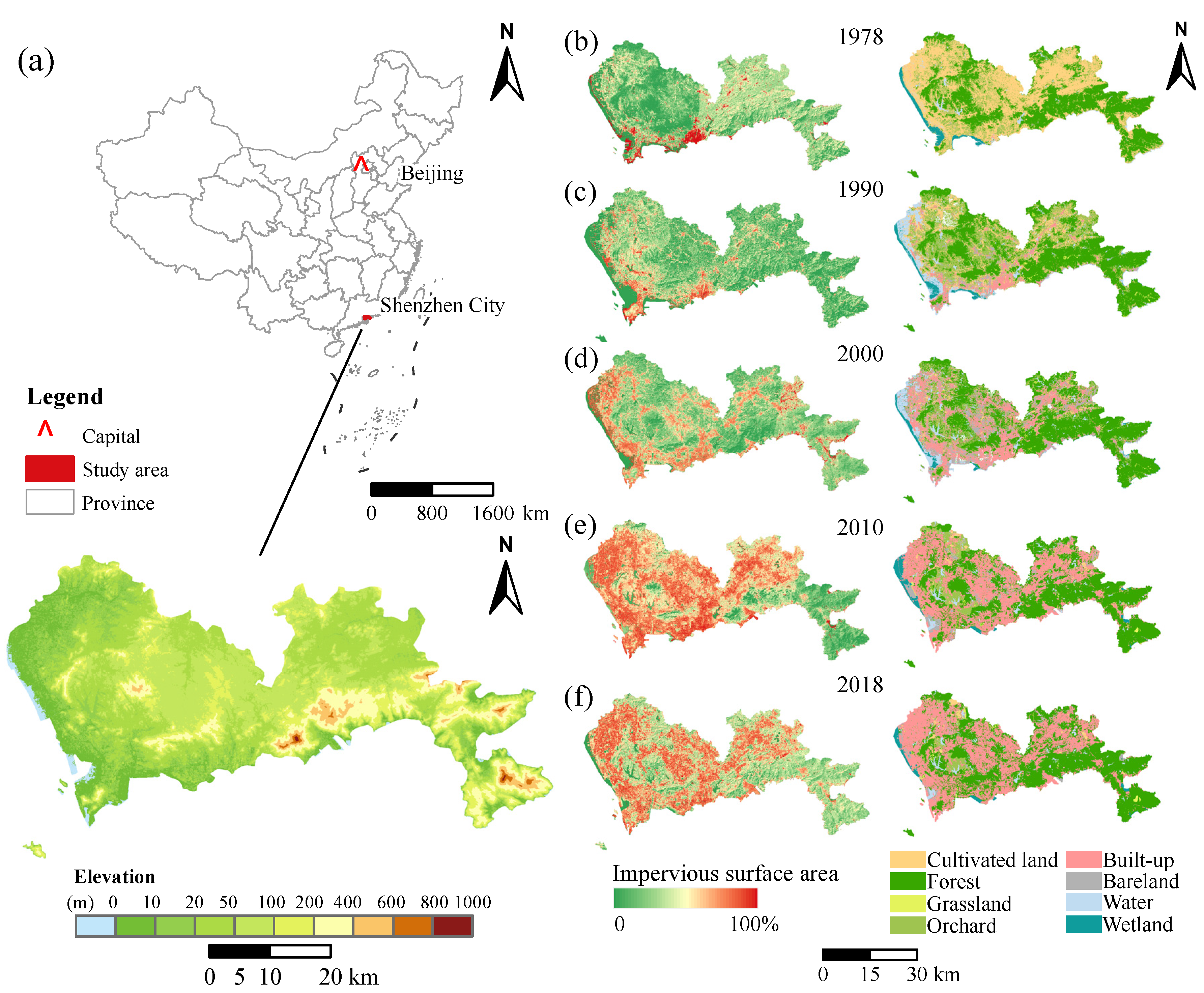
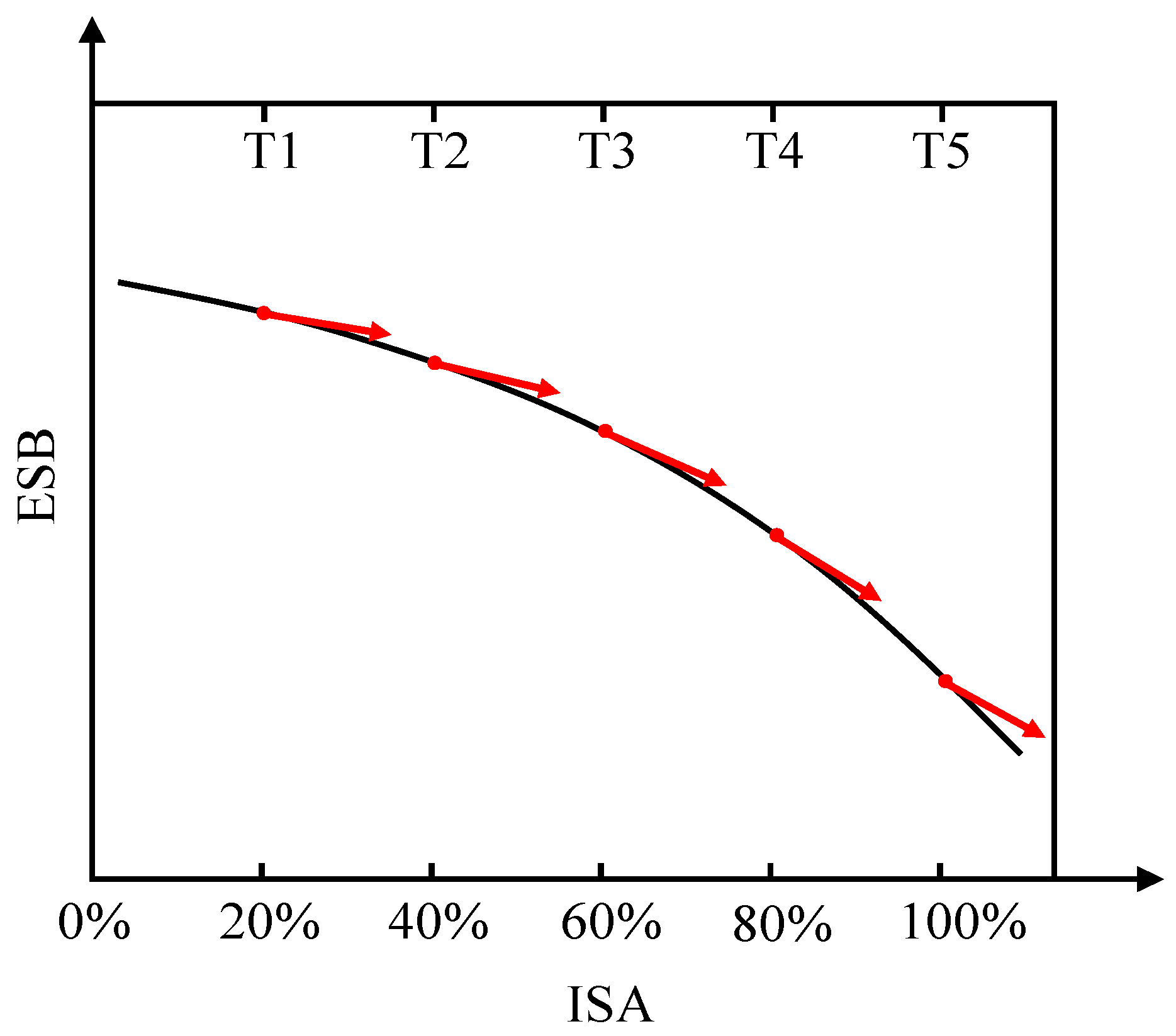


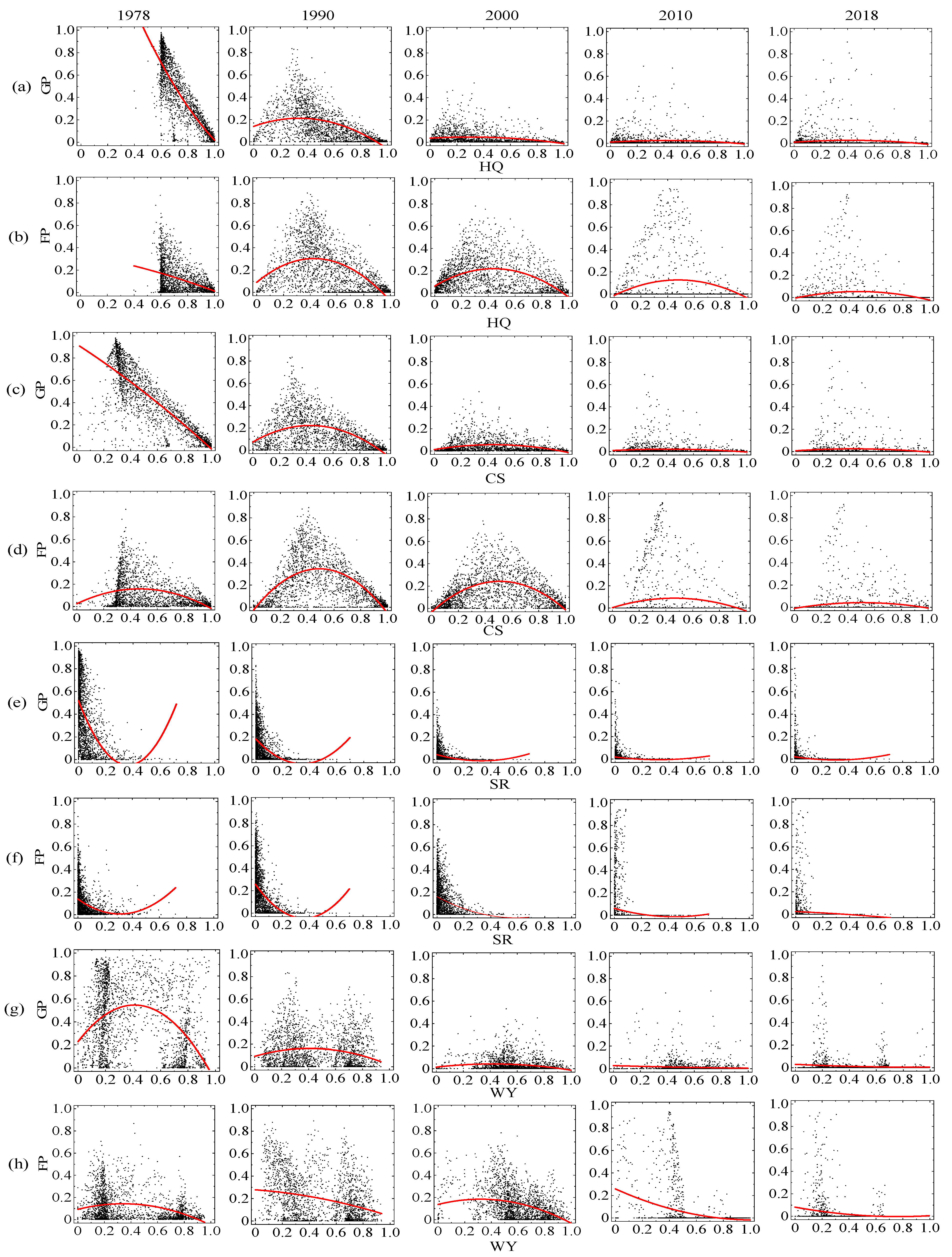
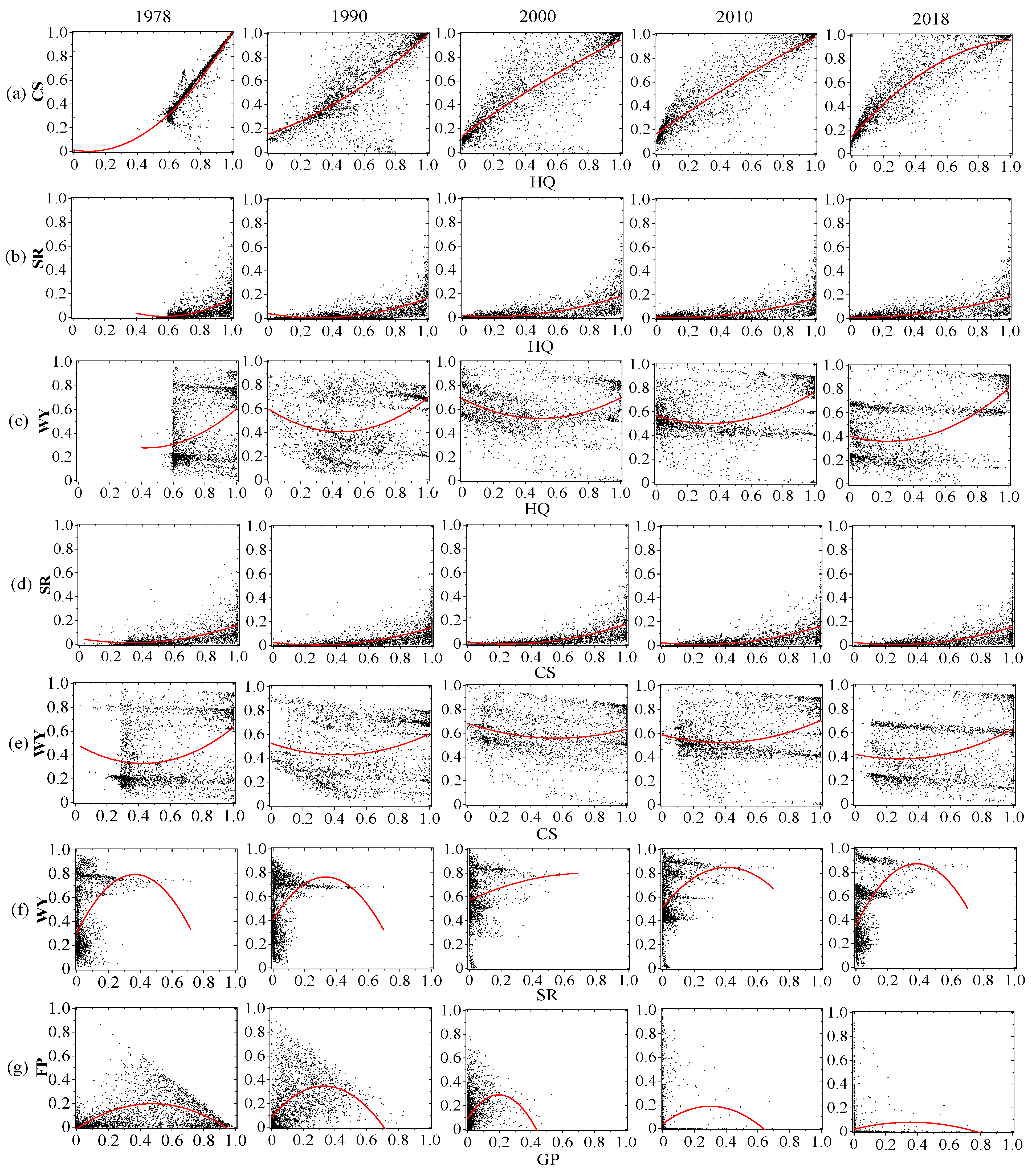
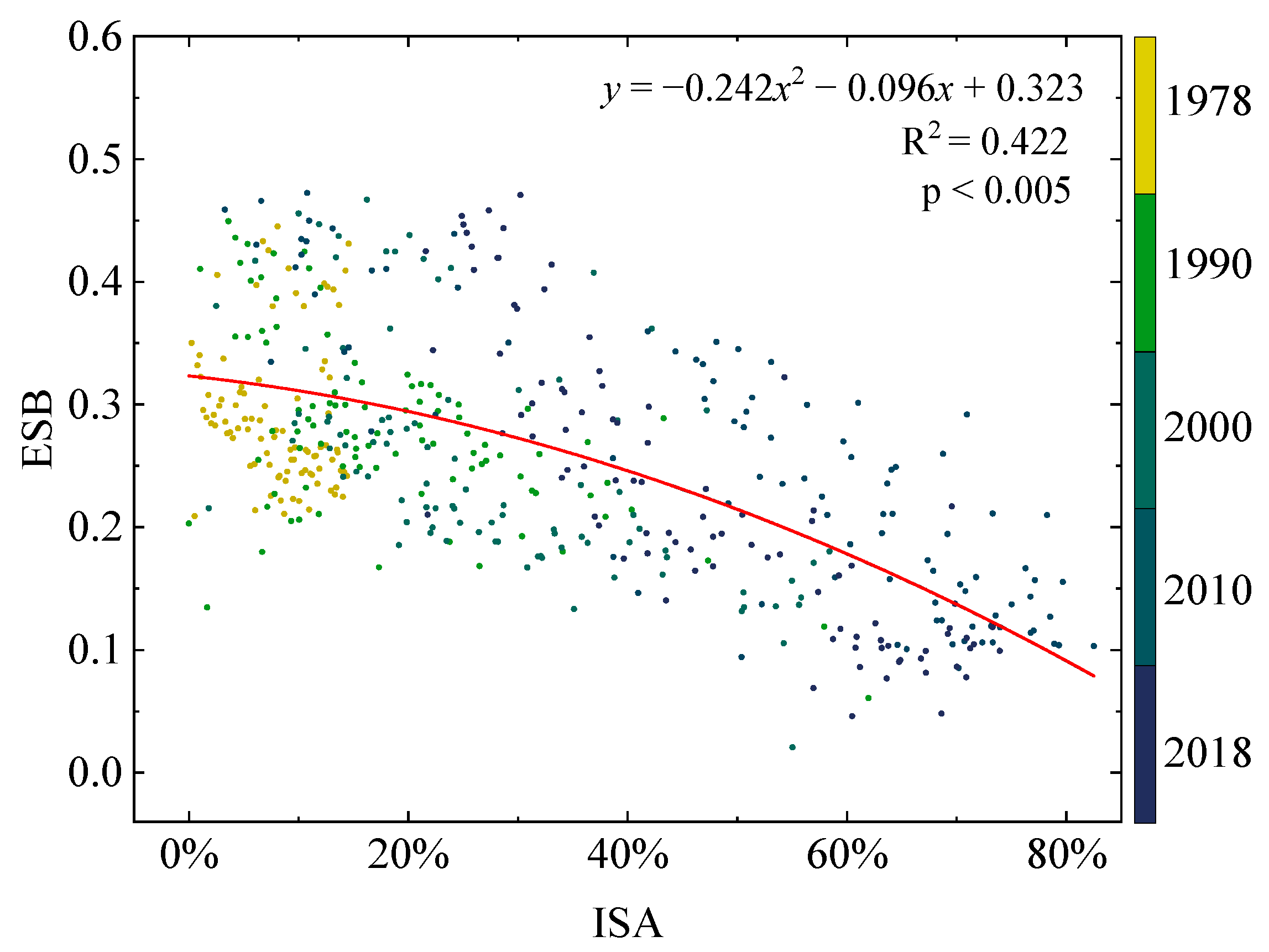
| Type | Description | Usage | Source |
|---|---|---|---|
| Landsat remote sensing images | Landsat 1–3 MSS images of 1978, Landsat 4–5 TM images of 1990, 2000, and 2010, and Landsat 8 OLI-TIRS images of 2018; 30 m resolution | Land use type classification | Geospatial Data Cloud Platform of Computer Network Information Center, Chinese Academy of Sciences(http://www.gscloud.cn, accessed on 12 September 2020) |
| Land use type | Five years: 1978, 1990, 2000, 2010, and 2018; 30 m resolution | Assessment of multiple ecosystem services | Interpreted from Landsat series remote sensing image data |
| Precipitation Data | Rainfall in the corresponding year | Calculation of rainfall erosivity and water yield | Shenzhen hydrological statistical yearbook |
| Temperature data | Average daily temperature for the corresponding year | Calculation of potential evapotranspiration | NOAA (http://www.ncdc.noaa.gov, accessed on 12 September 2020) |
| Soil type data | Soil type and corresponding soil texture | Assessment of soil retention and water yield | Shenzhen Planning and Land Resources Committee |
| Road network | Linear vector data | Assessment of Habitat Quality | OpenStreetMap |
| DEM | Digital elevation model | Watershed and sub-watershed division, slope length and slope factor calculation | Shenzhen Planning and Land Resources Committee |
| Crop yield | The yield per unit of grain and fruit | Assessment of grain supply and fruit supply | Shenzhen Statistical Yearbook |
| Parks | Type, boundary, area, and year of opening | Evaluation of park recreation services | Shenzhen City Administration Bureau, Baidu map |
| Impervious surface area (ISA) | Five years: 1978, 1990, 2000, 2010, and 2018; 30 m resolution | Landscape urbanization level measurement | Interpreted from Landsat series remote sensing image data |
| Boundary of administrative division | Boundary vector data of each administrative district in Shenzhen; acquired in 2015 | Zonal statistics | Shenzhen Planning and Land Resources Committee |
| LULC | Cropland | Orchard | Forest | Built-Up | Water | Bare Land | Wetland | Grassland |
|---|---|---|---|---|---|---|---|---|
| C | 0.38 | 0.18 | 0.004 | 0 | 0 | 1 | 0 | 1 |
| P | 0.02 | 0.4 | 1 | 1 | 0 | 1 | 1 | 1 |
| Soil Type | K Value |
|---|---|
| Coastal sandy field/mudflat soil | 0.134 |
| Lateritic red soil | 0.191 |
| Sand shale yellow soil | 0.205 |
| Yellow mud soil | 0.209 |
| Granite yellow soil | 0.221 |
| Granite red soil | 0.232 |
| Red mud soil | 0.250 |
| Black mud field/Chisley soil/Vegetable field | 0.268 |
| Sand shale lateritic soil | 0.277 |
| Alluvial soil/Tidal sand soil/Delta sedimentary soil | 0.284 |
| Sand shale red soil | 0.291 |
| Eroding red soil | 0.292 |
| Saline soil/Acid sulfate paddy soil | 0.295 |
| Marsh soil | 0.303 |
Publisher’s Note: MDPI stays neutral with regard to jurisdictional claims in published maps and institutional affiliations. |
© 2022 by the authors. Licensee MDPI, Basel, Switzerland. This article is an open access article distributed under the terms and conditions of the Creative Commons Attribution (CC BY) license (https://creativecommons.org/licenses/by/4.0/).
Share and Cite
Liu, Z.; Liu, Z.; Zhou, Y.; Huang, Q. Distinguishing the Impacts of Rapid Urbanization on Ecosystem Service Trade-Offs and Synergies: A Case Study of Shenzhen, China. Remote Sens. 2022, 14, 4604. https://doi.org/10.3390/rs14184604
Liu Z, Liu Z, Zhou Y, Huang Q. Distinguishing the Impacts of Rapid Urbanization on Ecosystem Service Trade-Offs and Synergies: A Case Study of Shenzhen, China. Remote Sensing. 2022; 14(18):4604. https://doi.org/10.3390/rs14184604
Chicago/Turabian StyleLiu, Zhenhuan, Ziyu Liu, Yi Zhou, and Qiandu Huang. 2022. "Distinguishing the Impacts of Rapid Urbanization on Ecosystem Service Trade-Offs and Synergies: A Case Study of Shenzhen, China" Remote Sensing 14, no. 18: 4604. https://doi.org/10.3390/rs14184604
APA StyleLiu, Z., Liu, Z., Zhou, Y., & Huang, Q. (2022). Distinguishing the Impacts of Rapid Urbanization on Ecosystem Service Trade-Offs and Synergies: A Case Study of Shenzhen, China. Remote Sensing, 14(18), 4604. https://doi.org/10.3390/rs14184604








